Serviços Personalizados
Journal
Artigo
Compartilhar
Educação em Revista
versão impressa ISSN 0102-4698versão On-line ISSN 1982-6621
Educ. Rev. vol.34 Belo Horizonte 2018 Epub 20-Set-2018
https://doi.org/10.1590/0102-4698185913
Article
FIRST-YEAR STUDENT PROFILE IN THE “BACHELOR’S DEGREE WITH A TEACHING CREDENTIAL IN NURSING” PROGRAM AT A BRAZILIAN PUBLIC UNIVERSITY
2Ribeirão Preto College of Nursing, University of São Paulo, Ribeirão Preto, SP, Brasil
This study is conducted within the context of increased admissions at public universities. The study’s objective is to describe and analyze, through exploratory/descriptive research, the profile of first-year students from 2006 to 2015 of the “Bachelor’s Degree with a Teaching Credential in Nursing” program at the University of São Paulo, Ribeirão Preto College of Nursing. A questionnaire was applied as the means of data collection, which obtained personal identification data as well as professional, educational, and cultural data. Participants were first-year students in the aforementioned program, from the program’s founding class of students in 2006 through the entering class of 2015. From the data analysis, we observed substantial changes in the first-year student profile, especially with regard to age, previous education, and employment status. Knowing these changes is important for implementation of the political-pedagogical proposal of the program.
Keywords: Student; Nursing; Educator training; University; Teaching credential
Este estudo faz parte de contexto de ampliação de vagas públicas no ensino superior. Tem como objetivo descrever e analisar o perfil dos estudantes ingressantes do curso de Bacharelado e Licenciatura em Enfermagem, da Escola de Enfermagem de Ribeirão Preto/Universidade de São Paulo (EERP/USP), de 2006 a 2015, por meio de estudo de natureza exploratório-descritiva, utilizando questionário como técnica de coleta de dados, contendo dados de identificação pessoal, profissional, escolar e cultural. Os participantes foram os alunos ingressantes no curso citado, desde a primeira turma, em 2006, até o ano de 2015. A partir da análise dos dados, foram observadas mudanças no perfil de aluno ingressante no que se refere, principalmente, à faixa etária, escolaridade prévia e ingresso de trabalhadores. No contexto universitário, conhecer essas mudanças é importante para a implementação da proposta político-pedagógica desse curso.
Palavras-chave: Estudante; Enfermagem; Formação de professores; Ensino superior; Licenciatura
INTRODUCTION
This study was conductedin a credential degree course involving the training of generalist nurses and teachers for vocational secondary-level technical education (EPTNM). The National Curricular Guidelines for Nursing Graduation (BRAZIL, 2001a) govern the baccalaureate education requirementsfor different health services, as well as the possibility of a degree that focuses on training nurses who can teach at EPTNM, within the scope of technical schools. According to the Guidelines, nursing courses that choose to offer baccalaureate degrees, in addition to providing a credential degree, must also follow specific legislation for teacher education in Brazil.
The current guidelines for teacher education, including EPTNM (BRAZIL, 2015), allow training of teachers in specific courses, withtheir particularprojects, and can focuson baccalaureate or technological development. Credential degrees are one route for this training, despite the weaknesses marking the teacher education policy for professional education in Brazil (MACHADO, 2008). Undergraduate nursing courses are few compared to baccalaureate courses, but have existed since the 60s, and currentlyenable the training of generalist nurses and EPTNM teachers in the healthcare/nursing area.
In nursing, EPTNM is dedicated to training auxiliary workers and nursing technicians. These workers form the majority of the nursing team (77%) (MACHADO et al., 2016), and are responsible forhealthcare actions involvingthe Brazilian population. In this context, joint training of nurses and EPTNM teachers could have an important social role concerning Brazil’s healthcare and education.
The Nursing course (credential and bachelor’s degree) was originally created and implemented in a public university in the state of São Paulo. This university admitted 50 students for the evening/night period (2:00 p.m. to 11:00 p.m.), hearkening back to a historical moment institutionally marked by a policy of expanding admissions—mainly for the night period—and social inclusion (PENIN, 2005), and nationally marked by a policy of increasing access to higher education for young people aged 18 to 24 (BRAZIL, 2001b). This policy is part of the globalization and capital flexibilization processes (FERREIRA & OLIVEIRA, 2011) that have implications for the expansion and acceleration of worker training for the labor market.
In 2002, a new Nursing course (bachelor’s and credential degree) was proposed within the institution for the afternoon/evening timeto maintain institutional commitment to training licensed nurses, consideringadmissions thus far available to a complementary credential degree coursewere no longerpolitically/legally viable, given new legislation in the field of education, which considered the credential a degree program. Additionally, this new training course would expand access to public university for young people from lower classes, abiding by a broader policy, as stated.
The baccalaureate and credential nursing program began in this complex context. The 4,575-hour course seeks to build a professional profile that provides general training of nurses and EPTNM teacher training, and aims to contribute to constructing integral healthcare and the ethical/political and technical training of secondary-level technical workers.
Understanding the incoming students could be essential to the public institution for monitoring development of the baccalaureate and credential nursing program. Who are the students entering the program? What is their socioeconomic, educational, and professional background?
The goal of this study is to describe and analyze the profile of new students from 2006 to 2015 in the Baccalaureate and Credential Nursing program of the Ribeirão Preto College of Nursing, University of São Paulo (EERP/USP).
METHODOLOGY
This exploratory/descriptive study used a questionnaire as the data collection technique. The questionnaire was composed of closed and open questions concerning personal, professional, educational, and cultural data, and was built based on the instruments used to trace the profile of USP-RP’s first-year students in 2006, as well as the research questionnaires of the Brazilian Institute of Geography and Statistics (IBGE, 2000; 2003). The research project was approved by the Research Ethics Committee of EERP/USP. The participants were first-year students who enrolled in the Baccalaureate and Credential Nursing programof EERP/USP from its first class in 2006 to the entering class of 2015. The questionnaires were applied yearly during the enrollment period. Participation was voluntary and confidential, avoiding possible embarrassments. The objective and benefits of this study were presented upon data collection, along with the Free and Informed Consent Term (TCLE), which was signed by each student. The data obtained from the closed questions, which are the focus of this article, were organized in tables and frequency distribution graphs using the EpInfo software.
Results and Discussion
A total of 421 students who enrolled in the Baccalaureate and Credential Nursing program from 2006 to 2015 answered the survey (85.74% of the 491 students enrolled in the program). Some results, subdivided into items, will be pointed out and discussed below.
Gender, age, and marital status
The gender of the first-year studentparticipants (Graph 1), was predominantlyfemale in all years analyzed. The year 2007 stood out, in which 93.4% of participants were women, while only 6.5 % were men. It should be noted thatthe average number of female first-year students in 10 years was 82.58%.
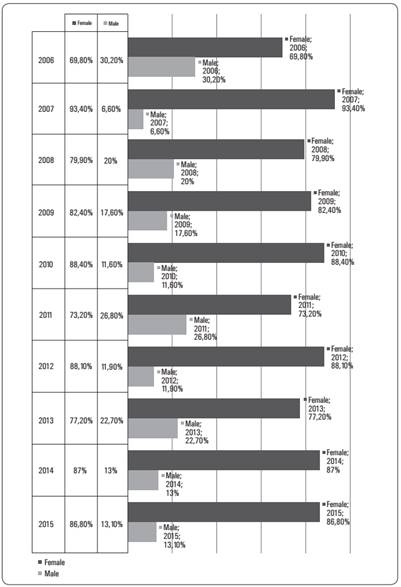
Source: Created by the authors based on participants’ responses
Graph 1 Distribution of participants by gender, 2006-2015.
Despite the prevalence of women in nursing courses, as shown in other studies (SPÍNDOLA et al., 2008; CORRÊA et al., 2011; NARDELLI et al., 2013; SOUZA et al., 2013; BUBLITZ et al., 2015), a not insignificant enrollment of men was observed in the nursing course in question, especially in the years 2006, 2011, and 2013. Since the early 1990s, male presence has increased in this professional category, despite the female prevalence (MACHADO et al., 2016).
Donati et al. (2010) cited a “feminization” tendency in the healthcare workforce, noting the prevalence of female students compared to male students in the nursing program of a private higher education institution (HEI) in São Paulo state. This trend is also noted by Machado et al. (2006, 2011) in studies that indicate growing female participation in the healthcare sector, particularly after the 1970s. In 2006, women prevailed among healthcare professions, namely within the nutrition, nursing, and psychology professions (MACHADO et al., 2006). As of 2011, women represented 70% of the healthcare workforce, denoting a process of feminization involving professions historically considered masculine, such as medicine (MACHADO et al., 2011).
Specifically, the prevailing female characteristics of the nursing professional profile are related to its social and historical context, which beginsin its origins as a service organized by religious institutions, and coexists with the association of women with domestic care and holding informal knowledge on healthcare practices (LOPES & LEAL, 2005). According to Lopes and Leal (2005), when care is consideredan intrinsically feminine action, nursing is perceived as support for the physician’s truly scientific work, and the conditions of tiresome, routine, and Taylorized work, and the need to provide constant care, is thus seen as natural. Thus, the different competence concepts for treatment (scientific) and care (support) corroborate thehierarchical structure of healthcare work and low salaries for nursing (LOPES & LEAL, 2005).
Similar to nursing, a specific characteristic of teaching is a feminine preponderance in the workforce, even more so in the first years of basic education (VIANNA, 2002; CHAMON, 2005). However, in the 2007 Census of Basic Education, the Ministry of Education (MEC) has identified that the female profile of elementary teachers decreased in the levels following primary and secondary education. Thus, in 2007, whereas 97.9% of daycare teachers were women, this percentage dropped to 46.7% in professional education, characterizing teachers in vocational education as predominantly male. The study did not distinguish areas of knowledge, and thus does not have specific data on professional healthcare education (INEP, 2009).
Students aged 18 to 24 years formed theprevailing age group of this study’s participants (Graph 2), with a significant increase in enrollment of students younger than 18 since 2012.
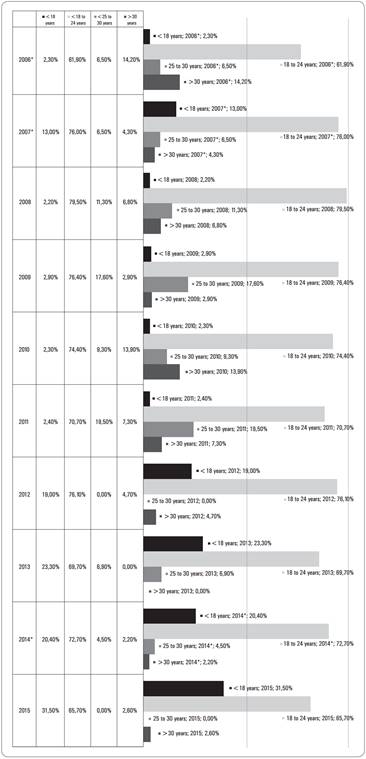
Source: Created by the authors based on participants’ responses. *one participant did not answer this question
Graph 2 Distribution of participants by age, 2006-2015.
A greater influx of students aged 30 and over in 2006 and 2010 is clear. In 2006, this may be associated with the highest enrollment of employed first-year students (41.86%; Graph 10). Thisprogramwas originally part of a policy to expand night admissionsadopted by the USP Dean of Graduation (PRG-USP) in 2002, which aimed to increase the number of university admissionsand democratize education (PENIN, 2005). Thus, the establishment of a night course may be linked to the entry of workers aged 30 years and over. However, the demand for academic activities may make it difficult for working students to remain enrolled, because it is an afternoon/evening program. It is assumed, therefore, that this situation is related to the reduced income of this part of the population during the years analyzed, and the increase in the younger population that has not yet entered the labor market.
The number of participants under the age of 18 was low in the first six years of the program (4.1% on average), and rose between 2012 and 2015 (23.55% on average; Graph 2). Most studentsentering this program are between 18 and 24 years of age.
Other studies show trends similar to those found in the present study (NARDELLI et al., 2013, BRAZIL, 2014). The impact of the policy to expand public higher education, driven by the National Education Plan (PNE) at the national level, was observed in the increased enrollment of the population aged between 18 and 24 years, most significantly since 2001. The 2001 PNE highlighted, by means of a situational diagnosis, a movement to increase demand for admissions in public higher education due to demographic changes and labor market requirements, and established the objective to provide admissions in the higher-level education system to 30% of people aged 18 to 24 years by 2011 (BRAZIL, 2001B; VARGAS & PAULA, 2013; BRAZIL, 2014). Thus, as mentioned, the university offeringthis study’s focus programalso adopted the policy of increasing admissions from 7,175 to 9,952 between 2002 and 2005, ensuring that 34.66% of these were for the night period (PENIN, 2005).
In all the years studied except for 2006 and 2008, 90% or more new students declared a single marital status (Graph 3).
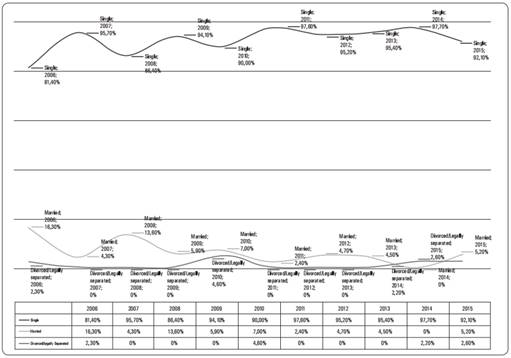
Source: Created by the authors based on participants’ responses.
Graph 3 Distribution of participants by marital status, 2006-2015.
The enrollment of young and single students illustrates their greater time availability and dedication to the extensive hours required by nursing programs (DONATI et al., 2010). However, an early professional choice requires maturity, needed for certainty in one’s career choice and ability to face the actual conditions of being a nurse (SPÍNDOLA et al., 2008). Furthermore, given the specific training also aimed at secondary technical education in nursing (EPTNM), many young people do not have a clear understanding of theprogram, which comprises both training in nursing and teaching in EPTNM. Therefore, rethinking institutional pedagogical demands in educational training is necessary, considering the profile of the student and of the already-graduated nurse/EPTNM teacher (SORRINI & CORRÊA, 2014).
Prior education, parents’ education level, and race
The past school history of participants showed a prevalence of students coming from public elementary schools (Graph 4), as well as a decline in students from public schools and an increase of students from private schools in 2012. The year 2006 saw the least number of students enter the program from private high schools (Graph 5).
This percentage is still meaningful, despite a decline in enrollment of students from public schools. A significant increase in students coming from private schools began in 2013. In 2012, 2014, and 2015, the number of students from private schools was higher than that of public schools in other years, and did not represent an expressive numerical difference as in previous years, when students from public schools prevailed.
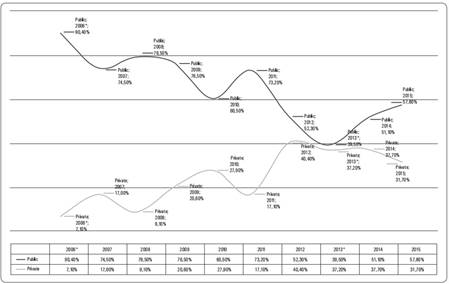
Source: Created by the authors based on participants’ responses. *one participant did not answer this question
Graph 4 Type of elementary school attended by participants, 2006 and 2015.
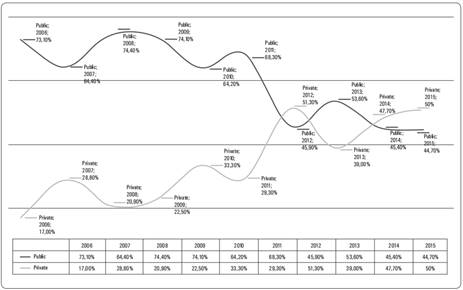
Source: Created by the authors based on participants’ responses.
Graph 5 Type of high school attended by participants, 2006-2015.
The Area Reportfor the 2013 National Student Achievement Examination (Exame Nacional de Desempenho dos Estudantes; ENADE) shows a trend in which high school students from public schools in most cases pursue higher education at private institutions, whereas students who have attended private institutions generally obtain their higher education at public HEIs (INEP, 2015). This trend was also found in another study carried out to track the profile of new students (VASCONCELOS & LIMA, 2010).
The profile of enrollees in the focus course differs from that of nursing courses in other public HEIs in that the number of students from private high schools exceeded the number of students from public schools. Still, recent data show increased admissions of students from the public school system to the University of São Paulo (USP, 2012) in 2012, 2014, and 2015.
The university offering the focus course conducts the USP Social Inclusion Program (INCLUSP). This program was created in 2006 to increase access for and permanence of public school students at the university. Among the program’s initiatives was the USP Serialized Evaluation Program (PASUSP), which, beginning in 2015, ensured a benefit of up to 25% in the entrance examination to students from public schools. As a result, in 2012, the number of students using PASUSP increased from 5% to 8%, and of students coming from public schools from 16% to 20% (USP, 2012). It is also noteworthy that USP adopted the Unified Selection System (SiSU) in 2015.
From 2007 to 2015, thenumber of students entering the Nursing course via INCLUSP increased considerably, reaching 70% in 2008. The institution also saw lower enrollment of students in the full Bachelor of Nursing program (8-18 hours), as shown in Graph 6. The program does enable admission of people from less-favored economic classes. Piotto and Nogueira (2013) highlight the academic, social and economic difficulties faced by such students, which are mainly reflected in their relationship with university colleagues and their academic performance.
The education level of the parents of participants from 2006 to 2015was also obtained. On average, 32.79% of participants’ mothers completed elementary education, 44.53% finished high school, and 22.59% completed higher education (Graph 7), while 39.59% of fathers completed elementary school, 38.02% finished high school, and 22.28% completed higher education (Graph 8).
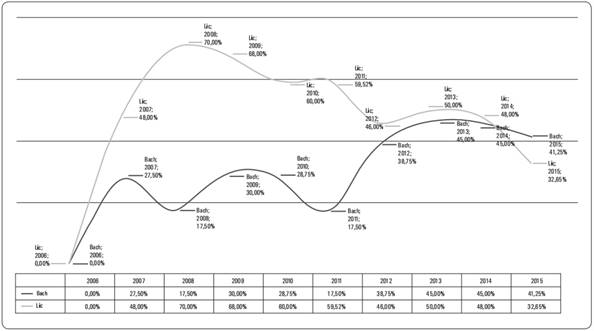
Source: EERP/USP graduation service, 2017.
Graph 6 Distribution of studentsnew to the two courses offered by EERP/USP who entered via INCLUSP, 2006-2015.
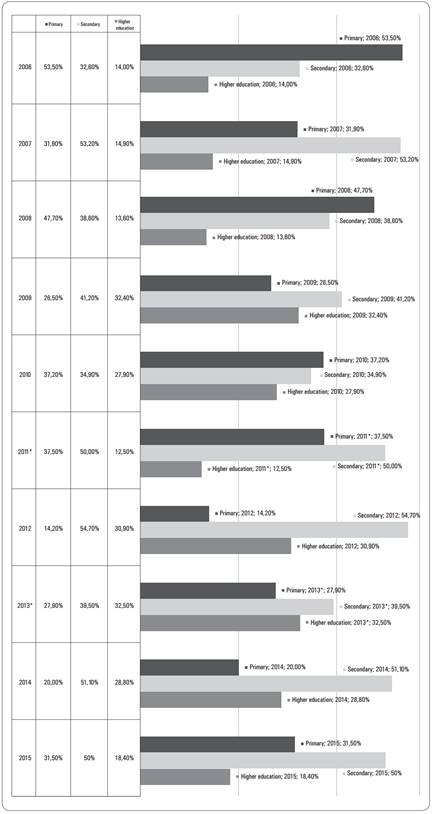
Source: Created by the authors based on participants’ responses. *one participant did not answer this question
Graph 7 Average education level of students’ mothers, 2006-2015.

Source: Created by the authors based on participants’ responses. *one participant did not answer this question
Graph 8 Average education level of students’ fathers, 2006-2015.
These data support those obtained by Vasconcelos and Lima (2010) for biology teachers from a federal HEI, indicating that graduates’ parents, for the most part, fell in the “high school” education level category. After analyzing the socioeconomic data of credential degree students in mathematics, pedagogy, and law at a private HEI, Palazzo and Gomes (2012) also identified that the education level of the students’ parents was high school, which is directly related to the socioeconomic level of those families. Studies have shown that nursing students from a private HEI also have low family income due to their parents’ low level of education, and the importance of strategies to ensure the permanence of these students in schoolis stressed (e.g., SOUZA et al., 2013). At the national level, parents of nursing students in the public HEI have a high school education level on average, with the mother’s education level being slightly higher than the father’s, though still mostly in high school (INEP, 2015). In this context, it is understood that people from higher socioeconomic levels tend to enter more socially prestigious programs, whereas students from families with lower education and purchasing power tend to enroll in less-valued programs, such as credential degrees/teacher training, denoting a process of inequality in the democratization of higher education (PALAZZO & GOMES, 2012).
Three factors play a decisive role in school success: family income, ethnic background, and parental education level (DURHAM 2003). Furthermore, parents’ education strongly influences their children’s education (e.g., see BRITO, 2007). This influence occurs in that parents with higher education levels tend to build families with higher income, influencing their children to choose careers bearing higher wage returns (PINTO, 2004). In the context of this study, students whose parents do not have a higher education level (related with the socioeconomic conditions of the family) prevail in both nursing—a profession with lower social prestige—and teacher training.
The race of first-year students from 2006 to 2015was also recorded. The data show that students of color and mainly indigenousstudents have been either a minority or nonexistent since the beginning of the course in 2006 (Graph 9). These data show that inclusion of black people in the public HEI remains low. Of all educational stages, higher education has the lowest presence of black people, and it should be noted that HEIs are responsible for training those responsible for the jobs that hold greater decision-making power (GARCIA, 2007). However, it should be emphasized that INCLUSPfacilitated an increase in the percentage of black peopleenrolled at USP (MATOS et al., 2012).
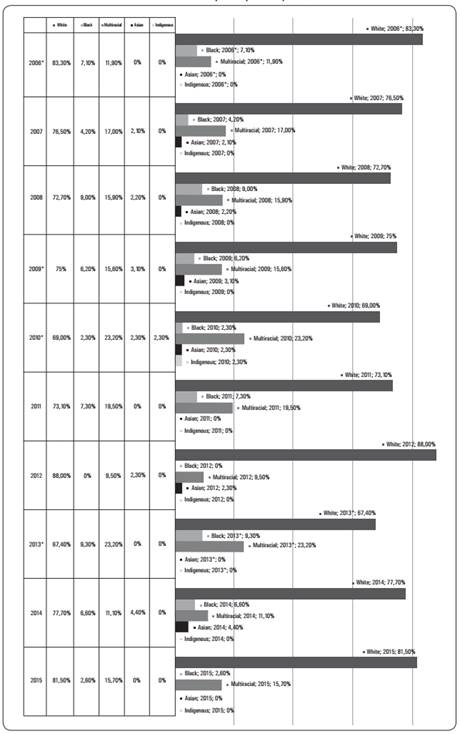
Source: Created by the authors based on participants’ responses. *one participant did not answer this question
Graph 9 Distribution of participants by race, 2006-2016.
IBGE statistics indicate a prevalence of people who declared themselves white, at 48.2% (91 million). However, in the first 10 years of the 21st century, the distribution of the Brazilian population changed racial identification, thus increasing the number of Brazilians who declared themselves to be people of color. Such change was associated with an intense tendency to regain racial identityin this period (Brazil, 2012).
The recovery of racial identity lead to a reconfiguration of the Brazilian population. In 2010, 6.9% of people declared themselves black and 44.2% declared themselves brown, representing 51.1% of the Brazilian population (i.e., the majority of the population). Previously, in 1999, this proportion was 5.4% black and 40% brown, according to the National Household Sample Survey (PNAD). In 2009, only 0.7% of Brazilians declared themselves indigenous or Asian. Thus, although the Brazilian population is mostly composed of citizens of color, for the program analyzed, the number of first-year students in this portion of the population remained low. This is also a reality in the public HEIs analyzed by ENADE (INEP, 2015).
The profile of HEI students does not reflect the Brazilian reality, and the percentages closest to this reality are foundin courses of low application/admission rate, including credential degrees (RISTOFF, 2014). However, initiatives such as Prouni and Fies in private HEIs and the Quota Law in the public HEI are helping to increase the admission of black people into more competitive programs, such as medicine (RISTOFF, 2014). Nevertheless, inequality persists in higher education admissions. Moehlecke (2004) states that, in addition to ensuring access to higher education for minorities—namely the black community, the indigenous community, and public school students—it is necessary to design policies for student retention and completion of higher education.
It should be noted that a racial quota policy was very recently approved at the university studied in this analysis, which was not in place during the years involved in this study.
Working students
The number of unemployed students was always higher, and the number of working students varied and declined through the years (Graph 10 and Table 1). However, the percentage of workers enrolled in a public university (4.5%), despite being lower than the percentage of non-workers (8%), is relevant when compared to the number of workers in other public IES, given that the Nursing course is a healthcare course with a high hourly load, held in a period that requires daytime study (WETTERICH & MELO, 2007; SPÍNDOLA et al., 2008). Federal institutions also show relevant percentages of working students (INEP, 2015). In 2013, 61.3% of men and 48.7% of women enrolled in nursing credential programs in public and private institutions had some paid work by the time of graduation (INEP, 2015). However, the number of working students in nursing programs is higher in private institutions.
Data on students who started working after enrollment in this program are not available, but could be a focus of other studies. The current experience in this program, such as with teachers and students, shows that working during graduation may occur.
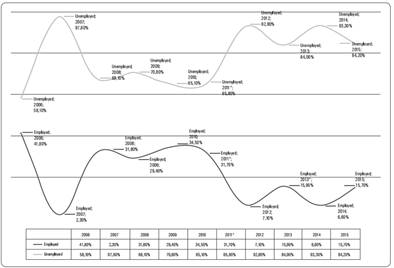
Source: Created by the authors based on participants’ responses.*one participant did not answer this question,
Graph 10 Distribution of participants by employment status, 2006-2015.
Table 1 Distribution of participants working as technicians and nursing assistants, 2006-2015.
| Year | Working first-year students | Nursing assistants | Nursing technicians | Other |
|---|---|---|---|---|
| 2006 | 18 | 6 | 3 | 9 |
| 2007 | 5 | 2 | 0 | 3 |
| 2008 | 14 | 4 | 3 | 7 |
| 2009 | 10 | 5 | 1 | 4 |
| 2010 | 15 | 1 | 0 | 14 |
| 2011* | 13 | 6 | 1 | 6 |
| 2012 | 3 | 0 | 0 | 3 |
| 2013 | 7 | 2 | 3 | 2 |
| 2014 | 3 | 0 | 0 | 3 |
| 2015 | 6 | 1 | 1 | 4 |
| Total | 94 | 27 | 12 | 55 |
Source: Created by the authors based on participants’ responses. *one participant did not answer this question,
The increased possibility for enrollment of working students in higher education can be understood in Brazil within the general context of expansion of HEI admissions under the administration of Fernando Henrique Cardoso by expanding private HEIs and opening night courses on the outskirts of large urban centers.These measures were part of the economic policy then adopted, and in line with globalization and flexible capital accumulation which demanded a reconfiguration of the state’s role and reorganization of public policies (CUNHA, 2003, 2007).
Subsequently, public higher education was strengthened and expanded further by the Lula administration, with the adoption of a quota system and elaboration of the Program for Support to Restructuring and Expansion Plans of Federal Universities (REUNI), which has among its objectives the reduction of evasion rates, occupation of idle vacancies, and increase of ingress vacancies, especially for night courses (MARTINS, 2009).
Despite these initiatives, the expansion conducted by the federal government was unable to democratize access to higher education, despite expanding the potential for ingress, and there is still a need for policies addressing the social inclusion of workers in higher education (BRAZIL, 2014).
Considering that the creation of the course analyzed also happened to meet strategic demands for expanded night vacancies, it also created the potential for ingress of workers who need to hold paid work concurrently with their higher education. In this sense, it is important to remember the difficulties experienced by workers in beginning and remaining in higher education, and in this program specifically, factors that may be related to the decline of incoming workers in recent years.
Iglesias (2002) reports that the working student nurses possess limited time and financial resources, which leads them to choose courses in private HEI, they offer a greater number of vacancies and part-time programs, allowing students to continue to work during their study. In a study conducted with technicians and nursing assistants who were studying nursing, Fontana and Bringo (2011) infer from participants’ responses that working students experiences changes in quality of life due to their multiple duties, which hinder opportunities for rest and leisure.
In all years analyzed except for 2012 and 2014, some students worked in the nursing field. However, contrary to data from other studies conducted in public HEIs, in which the majority of working students were from the healthcare field, and among these the majority were middle-level technical workers in nursing (WETTERICH&MELO, 2007; PIERANTONI, 2008; SPÍNDOLA et al., 2008), the average number of technical workers in nursing during the 10 years analyzed was lower (3.9%) than in other areas (5.5%).
When analyzing the motivations of healthcare workers to enter a nursing program at a private HEI, Souza (2008) identified that among the expectations noted by the participants was improved quality of life through professional and social ascension. The participants of this study understood that having a nursing degree would allow them to seek better salaries and, thus, work only one job, so they could invest more time in their personal lives. In this same study, 91% of participants agreed that they chose the nursing profession so they could work fewer jobs, also mentioning that a nurse’s salary is double that of a nursing assistant (SOUZA, 2008).
However, although working students demonstrate positive expectations regarding the job market after completing their academic training, the nursing field has shown worrying rates of unemployment. In 2013, 10.1% of nursing professionals reported experiencing unemployment within the last 12 months, with an aggravated situation among nurses, in which this percentage reached 12.4%. In other words, 51,000 nurses said they experienced unemployment within the last 12 months. Moreover, of the 121,000 nursing professionals who reported unemployment, 66.7% said they had problems finding jobs in their area (MACHADO et al., 2015). Silva et al. (2012), when studying the shape of the labor market for nurses in the state of Minas Gerais, identified an imbalance between the number of trained professionals and their possible absorption by the labor market, although the number of professionals trained is still not enough to provide service to the population.
Thus, the present data allow investigation of some personal, professional, and educational characteristics of students entering a Baccalaureate and Credential Nursing program, as well as their changes over the period studied.
FINAL CONSIDERATIONS
In this context of expanding HEI admissions, expressive changes in the profile of incoming students, mainly in age, previous education, and employment status, were observed from the establishment of the Baccalaureate and Credential Nursing program at EERP/USP in 2006 to 2015.
An expressive increase in the admission of students under the age of 18 in the latter years of this study likely occurred in response to increased admission of students between 18 and 24 in the public university, despitethe greater age diversity among the participants of the early years of the program. The first class comprised more students in the 25-30 and the 30-and-above agegroupsin comparison to later years.
The number of students coming from public high schools declined, although this percentage remained expressive, dueto the number of students using the INCLUSP program to enroll in the program. This program was created withreference to the political intent to expand admissions, and to a context marked by an institutional policy of social inclusion. It may truly be considereddifferent regardingadmissions, given the inclusion of people from less favored social classes.
However, careful monitoring is needed in the years to come given the increasing number of students coming from private schools. More intensive investment in disseminatinginformation about the program to public high schools will be important, including technical schools in healthcare, where many students study in EPTNM and may have an interest in entering the public university, a reality often far from their everyday life.
The number of students coming from private high schools has increased in recent years. However, parents with mainly a high school education level, for example, can indicate a socioeconomic condition consisting of less favored families, as would be observed in programs of greater social prestige.
In any case, the admission of students from public schools brings specific demands for university education, and the need to increase policies that support retention of these students.
The admission of workers has always been lower than that of non-workers. However, the percentage reported in this study can be consideredexpressive when considering that the program analyzed has characteristics that hinder keeping jobs (e.g., high workload, healthcare-related field, evening-night periodstudy that involves daytime hours). More working students are enrolled in this nursing program compared to the percent of nursing students and workers in the public HEI.
The presence of people already in the nursing field is noteworthy, as this shows a perspective of social ascension, despite current employment limits in the area, asnoted in research related to the job market.
Based on the data presented, it is important to continue this study tracing the profile of incoming students to identify possible implications for pedagogical practices and management of the course in question. The intention should be to implement theprogram’s political-pedagogical proposition based on the characteristics of its incoming students, and to promote emancipatory formative processes that surpass simply meeting market demands.
REFERÊNCIAS
BRASIL. Censo 2010 mostra as características da população brasileira. Portal Brasil. Brasília, 2012. Disponível em:<Disponível em:http://www.brasil.gov.br/educacao/2012/07/censo-2010-mostra-as-diferencas-entre-caracteristicas-gerais-da-populacao-brasileira >. Acesso em: 30 jul. 2017. [ Links ]
BRASIL. Conselho Nacional de Educação. Resolução CNE/CES nº3, de 7 de novembro de 2001. Institui Diretrizes Nacionais do Curso de Graduação em Enfermagem. Resolução CNE/CES-03/2001. Diário Oficial da União, Brasília, DF, 1 out. 2001a. [ Links ]
BRASIL. Conselho Nacional De Educação. Resolução CNE/CP nº2, de 1° de julho de 2015. Institui Diretrizes Curriculares Nacionais para a formação inicial em nível superior e para a formação continuada. Resolução CNE/CP 02/2015. Diário Oficial da União, Brasília, DF, 2 jul. 2015. [ Links ]
BRASIL. Plano Nacional de Educação 2014-2024: Lei nº 13.005, de 25 de junho de 2014, que aprova o Plano Nacional de Educação (PNE) e dá outras providências. - Brasília: Câmara dos Deputados, Edições Câmara, 2014, 86p. Disponível em: <Disponível em: http://unesdoc.unesco.org/images/0013/001324/132452porb.pdf >. Acesso em: 14 fev. 2018. [ Links ]
BRASIL. Plano Nacional de Educação. Brasília: Senado Federal, UNESCO, 2001b, 186p. Disponível em: <Disponível em: http://www.observatoriodopne.org.br/uploads/reference/file/439/documento-referencia.pdf >. Acesso em: 14 fev. 2018. [ Links ]
BRITO, M. R. F. ENADE 2005: Perfil, desempenho e razão da opção dos estudantes pelas Licenciaturas. Avaliação, Campinas; Sorocaba, v. 12, n. 3, p.401-443, 2007. [ Links ]
BUBLITZ, S. et al. Sociodemographic and academic profile of nursing students from four Brazilian institutions. Revista Gaúcha de Enfermagem/EENFUFRGS, v. 36, n. 1, p. 77-83, 2015. [ Links ]
CHAMON, M. Trajetória de feminização do magistério: ambigüidades e conflitos. Autêntica, Rio de Janeiro, 2005. VI SEMINÁRIO DA REDESTRADO - Regulação Educacional e Trabalho Docente. [ Links ]
CORRÊA, A. K. et al. Perfil de estudantes ingressantes em licenciatura: Escola de Enfermagem de Ribeirão Preto da Universidade de São Paulo. Revista da Escola de Enfermagem USP, v. 45, n. 4, p. 933-938, 2011. [ Links ]
CUNHA, L. A. O ensino superior no octênio FHC. Educação e Sociedade, v. 24, n. 82, p. 97-61, 2003. [ Links ]
DONATI, L. J. A. et al. O perfil do estudante ingressante no curso de graduação em enfermagem de uma faculdade privada. Revista Enfermagem UERJ, v. 18, n. 3, p. 446-450, 2010. [ Links ]
DURHAM, E. R.. Desigualdade educacional e cotas para negros nas universidades. Novos Estudos. CEBRAP, S. Paulo, v. 66, p. 3-22, 2003. [ Links ]
FERREIRA, S.; OLIVEIRA, J. F. As influências da reforma da educação superior no Brasil e na União Européia nos papéis sociais das universidades. In: OLIVEIRA, J. F. O. “O campo universitário no Brasil: políticas, ações e processos de reconfiguração”. Campinas: Mercado de Letras, p. 39-62, 2011. [ Links ]
FONTANA R. T, BRIGO L. Estudar e trabalhar: percepções de técnicos de Enfermagem sobre esta escolha. Escola Anna Nery {online}, v. 16, n. 1, p. 128-133, 2011. [ Links ]
GARCIA, R. C. Identidade fragmentada: um estudo sobre a história do negro na educação brasileira: 1993-2005. Brasília: Instituto Nacional de Estudos e Pesquisas Educacionais Anísio Teixeira, 2007, 111p. [ Links ]
IGLESIAS, R. B. Qualidade de vida de alunos-trabalhadores que cursam a graduação em Enfermagem. São Paulo: Universidade de São Paulo, 2002. [ Links ]
INSTITUTO BRASILEIRO DE GEOGRAFIA E ESTATÍSTICA (IBGE). Censo Demográfico 2000, Brasília, 2000. [ Links ]
INSTITUTO BRASILEIRO DE GEOGRAFIA E ESTATÍSTICA (IBGE). Pesquisa Nacional por Amostragem de Domicílios (PNAD), Brasília, 2003. [ Links ]
INSTITUTO NACIONAL DE ESTUDOS E PESQUISAS EDUCACIONAIS ANÍSIO TEIXEIRA (INEP). Censo da Educação Superior 2014: Notas Estatísticas. Brasília: Ministério da Educação, 2015. [ Links ]
INSTITUTO NACIONAL DE ESTUDOS E PESQUISAS EDUCACIONAIS ANÍSIO TEIXEIRA (INEP). Estudo exploratório sobre o professor brasileiro com base nos resultados do Censo Escolar da Educação Básica 2007. Brasília: Ministério da Educação , 2009. [ Links ]
LOPES, M. J. M.; LEAL, S. M. C. A feminização persistente na qualificação profissional da enfermagem brasileira. Cadernos Pagu, n. 24, p. 105-125, 2005. [ Links ]
MACHADO, L. R. S. Diferenciais inovadores na formação de professores para a educação profissional. Rev. Bras. Educ. Prof. Tecnol., Brasília, DF, v. 1, n. 1, p. 8-22, 2008. [ Links ]
MACHADO, M. H. et al. Análise da força de trabalho do setor saúde no Brasil: focalizando a feminização. Rio de Janeiro: Fundação Oswaldo Cruz, Rede Observatório de Recursos Humanos em Saúde. 2006, 136p. [ Links ]
MACHADO, M. H. et al. Aspectos gerais da formação da enfermagem: o perfil da formação dos enfermeiros, técnicos e auxiliares. Enferm. Foco, v. 6, n. 2/4, p. 15-27, 2016. [ Links ]
MACHADO, M. H. et al. Características gerais da enfermagem: o perfil sociodemográfico. Enferm. Foco, v. 6, n. 1/4, p. 11-17, 2015. [ Links ]
MACHADO, M. H. et al. Tendências do mercado de trabalho em saúde no Brasil. In: Celia Pierantoni, Mario Roberto Dal Poz, Tania França. (Org.). O Trabalho em Saúde: abordagens quantitativas e qualitativas. 1ª ed. Rio de Janeiro: Cepesc-UERJ, v. 01, p. 103-116, 2011. [ Links ]
MARTINS, C. B. A reforma universitária de 1968 e a abertura para o ensino superior privado no Brasil. Educação e Sociedade, Campinas, v. 30, n. 106, p. 15-35, 2009. [ Links ]
MATOS, M. S et al. O impacto do Programa de Inclusão Social da Universidade de São Paulo no acesso de estudantes de escola pública ao ensino superior público gratuito. Rev. Bras. Estud. Pedagog., v. 93, n. 235, p. 720-742, 2012. [ Links ]
MOEHLECKE, S. Ação afirmativa no ensino superior: entre a excelência e a justiça racial. Educação & Sociedade, v. 25, n. 88, p. 757-776, 2004. [ Links ]
NARDELLI, G. G. et al. Perfil dos alunos ingressantes dos cursos da área da saúde de uma Universidade Federal. Revista de Enfermagem e Atenção à Saúde, v. 2, n. 1, p. 3-12, 2013. [ Links ]
PALAZZO, J.; GOMES, C. A. Origens Sociais Dos Futuros Educadores: a Democratização Desigual Da Educação Superior. Revista da Avaliação da Educação Superior (Avaliação), v. 17, n. 3, p. 877-898, 2012. [ Links ]
PENIN, S. T. S. Pró-Reitoria de graduação 2002/2005: reflexões. p. 1-14, 2005. [ Links ]
PIERANTONI, R. et al. Alunos de Graduação em Enfermagem - Perfil, Expectativas e Perspectivas Profissionais. Rede Obsevatório de Recursos Humanos em Saúde, p. 1-92, 2008. [ Links ]
PINTO, J. M. R. O Acesso à Educação Superior No Brasil. Educ. Soc., Campinas, vol. 25, n. 88 - Especial, v. 25, p. 727-756, 2004. [ Links ]
PIOTTO, D. C.; NOGUEIRA, M. A. Inclusão vista por dentro: a experiência via Inclusp. Educação (Porto Alegre), v. 36, n. 3, p. 373-384, 2013. [ Links ]
PRATES, A. A. P. Universidades vs terceirização do ensino superior: a lógica da expansão do acesso com manutenção da desigualdade: o caso brasileiro. Sociologias, Porto Alegre, n. 17, p. 102-1023, 2007. [ Links ]
RISTOFF, D. O novo perfil do campus brasileiro: uma análise do perfil socioeconômico do estudante de graduação. Avaliação, Campinas, Sorocaba, v. 19, n. 3, p. 723-747, 2014. [ Links ]
SILVA, K.L. et al. Expansão dos cursos de Graduação em Enfermagem e mercado de trabalho: reproduzindo desigualdades?. Rev. Bras. Enferm. v. 65, n. 3, p. 406-413, 2012. [ Links ]
SORRINI, R. F.; CORRÊA, A. K. Perfil dos estudantes de licenciatura em enfermagem de Ribeirão Preto - USP: ingressantes de 2013. IN: 22. SIICUSP, Ribeirão Preto, 2014. [ Links ]
SOUZA, J. F. A. O significado da graduação de enfermagem sob o prisma de um outro olhar: auxiliares e técnicos de Enfermagem. 2008. 149 f. Dissertação (Mestrado Profissional em Ensino em Ciências da Saúde) - Escola Paulista de Enfermagem, Universidade Federal de São Paulo. São Paulo. [ Links ]
SOUZA, N. V. D. O. et al. Perfil socioeconômico e cultural do estudante ingressante no curso de graduação em enfermagem. Rev. Enferm. UERJ, v. 21, n. esp.2, p. 718-22, 2013. [ Links ]
SPÍNDOLA, T. et al. Enfermagem como opção: perfil de graduando de duas instituições de ensino. Revista Brasileira de Enfermagem - REBEN, v. 61, n. 2, p. 164-9, 2008. [ Links ]
UNIVERSIDADE DE SÃO PAULO. Escola Pública aumenta percentual na USP Ribeirão. Jornal Eletrônico do Complexo Acadêmico de Saúde - FMRP-USP. Ribeirão Preto, 2012. Disponível em: <Disponível em: http://jornal.fmrp.usp.br/?p=11140 >. Acesso em: 30 jul. 2017. [ Links ]
VASCONCELOS, S. D.; LIMA, K. E. C. O professor de Biologia em formação: reflexão com base no perfil socioeconômico e perspectivas de licenciandos de uma universidade pública. Ciência & Educação (Bauru), v. 16, n. 2, p. 323-340, 2010. [ Links ]
VIANNA, C. P. O sexo e o gênero da docência. Cadernos Pagu, v. 17, p. 81-103, 2002. [ Links ]
WETTERICH, N. C; MELO, M. R. A. C. Sociodemographic profile ofunder graduate nursing students. Rev Latino-am Enfermagem, v. 15, n. 3, p.404-410, 2007. [ Links ]
Received: October 16, 2017; Accepted: March 02, 2018











 texto em
texto em 



